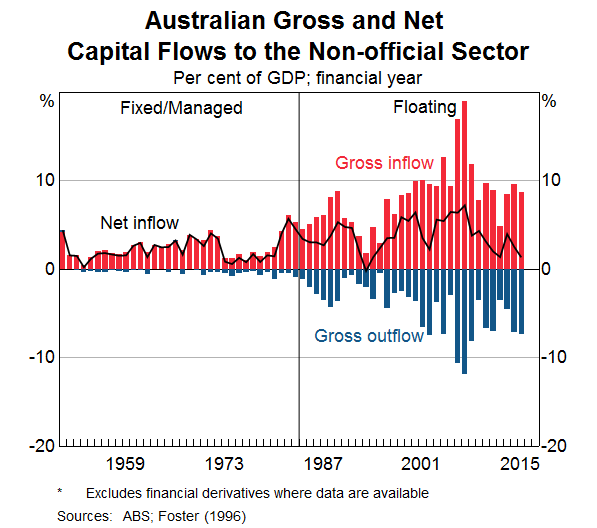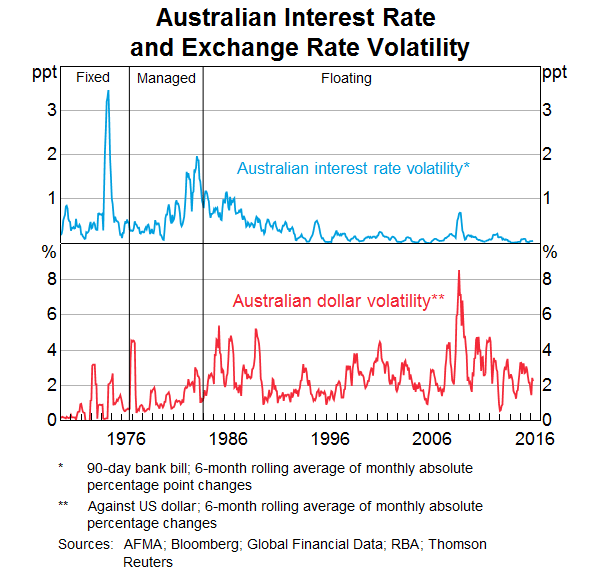Guy Debelle
Assistant Governor (Financial Markets)
RMB FX Forum (appearance via video link)
Beijing – 18 May 2016
I am very pleased to have the opportunity to speak at this event today. Australia takes a keen interest in the ongoing process of internationalisation and liberalisation of the renminbi (RMB). I am sure you will hear many interesting perspectives on that subject today.
I would like to talk about three things. First, I will talk a little about the use of the RMB in Australia. Second, I will talk about the RMB's increasing role in the global economy and relate that to the work I am leading on the Global Code of Conduct for the Foreign Exchange Market. Finally, I will provide an Australian perspective on currency internationalisation and capital account liberalisation, reflecting on the challenges that emerged as Australia went through this process in the late 1970s/early1980s.[1]
Turning to the use of the RMB in Australia. First, from the RBA's own point of view, we have invested a portion of our foreign exchange reserves in RMB since 2013. This has allowed us to get direct insight into the way the FX and bond markets function in China, and has also allowed us to experience first-hand the benefits of the ongoing liberalisation that has occurred in recent years. In June 2015, the People's Bank of China (PBC) reported that foreign central banks and monetary authorities held over RMB650 billion in RMB denominated assets and that has almost certainly grown larger today. The RBA and PBC also established a bilateral currency swap in 2012 for RMB200 billion that was renewed last year. The swap line highlights and supports the growing financial linkages between the two economies as well as trade and investment.
To help further remove possible impediments to the use of RMB in Australia, an official RMB clearing bank began operation in Sydney in February 2015. In addition, Australia was granted an RMB50 billion RQFII quota for portfolio investments. Finally, for a number of years now, the Australian dollar has been directly traded against the RMB in the onshore FX market.
This has allowed for the growing use of RMB in Australia. That said, the use of RMB remains noticeably less than the value of trade between China and Australia. In the RBA's conversations with Australian businesses that trade with China, one repeated concern raised that inhibits greater use of the RMB is the limited scope to hedge. In that regard, it is pleasing to see that RMB hedging instruments and markets are growing rapidly.
The ability to hedge was a very important development in the internationalisation of the Australian dollar. I will come back to this later on in my talk.
I will now talk about the increasing growth of RMB turnover in the foreign exchange (FX) market and relate to that the work on the Global Code of Conduct.
One of the most noteworthy developments in the 2013 Triennial survey of FX turnover, compiled by the Markets Committee that I chair at the BIS, was the rapid growth of RMB turnover since the 2010 survey. In particular, RMB turnover increased from US$34 billion per day in 2010 to US$120 billion per day in 2013.[2] The data for the 2016 Triennial FX turnover survey is in the process of being compiled now, based on a comprehensive survey of the FX market in April. I would presume that the 2016 survey is likely to show similarly rapid growth in RMB turnover over the past three years. In particular, turnover is likely to be bolstered by measures taken by the PBC to increase trade settlement and investment in RMB, as well as the various exchange rate initiatives that the PBC has taken since 2013. This includes increasing the flexibility of the RMB against the US dollar, with the trading band being widened to ±2 per cent from early 2014 and, more recently, the adjustment last August to the methodology for calculating the daily RMB fixing rate to make it more market-determined.
The 2016 Triennial FX turnover survey will likely confirm that the RMB is solidly in the top 10 currencies in terms of turnover, and may indeed be closing in on the Australian dollar, which is in fifth place in terms of turnover. Along with the RMB's recent inclusion in the SDR, this confirms the RMB's status as a global currency. With that prominence, comes an expectation that the functioning of the market will evolve towards the standards of behaviour and operation of the global FX market.
In that regard, some of you may be aware that a Global Code of Conduct for the FX market is being developed. I will now summarise that work for you and its potential relevance for the FX market in China.
Why is the Global Code being developed? As you are probably aware, the various scandals and evidence of inappropriate behaviour in the global FX market that have come to light over recent years have seen an erosion of trust in the FX industry, which is impeding its functioning. This lack of trust is evident both between participants in the market, but at least as importantly, between the public and the market. The global FX market needs to move toward a more favourable and desirable location, and allow participants to have much greater confidence that the market is functioning appropriately.
A well-functioning foreign exchange market is very much in the interest of all market participants. This clearly includes central banks, both in their own role as market participants but also as the exchange rate is an important channel of monetary policy transmission. In a globalised world, the foreign exchange market is one of the most vital parts of the financial plumbing.
The Global Code aims to set out global principles of good practice in the foreign exchange market to provide a common set of guidance to the market, including in areas where there is a degree of uncertainty about what sort of practices are acceptable, and what are not. This should help to address the lack of trust as well as promote the effective functioning of the wholesale FX market.
To that end, one of the guiding principles underpinning the work on the Code is that it should promote a robust, fair, liquid, open, and transparent market. A diverse set of buyers and sellers, supported by resilient infrastructure, should be able to confidently and effectively transact at competitive prices that reflect available market information and in a manner that conforms to acceptable standards of behaviour. I am confident that a similar set of principles are guiding the reforms to the FX market in China.
The work to develop the Global Code commenced in May last year, when the Bank for International Settlements (BIS) Governors commissioned a working group of the Markets Committee of the BIS to facilitate the establishment of a single Global Code of Conduct for the wholesale FX market and to come up with mechanisms to promote greater adherence to the Code.[3]
I am chairing this work, with Simon Potter of the Federal Reserve Bank of New York leading the work on developing the Code and Chris Salmon of the Bank of England leading the adherence work. Our working group comprises representatives of the central banks of all the major FX centres, including China, drawing on the membership of the Markets Committee which is comprised of heads of the market operations areas of the 15 major currency areas.[4] Given our roles, we are all very much interested in the effective functioning of the FX market. Again, it is very much a global effort reflecting the global nature of the foreign exchange market.
This work is also very much a public sector-private sector partnership. In that regard, we are being ably and vigorously supported in this work by a group of market participants, chaired by David Puth, CEO of our conference host CLS. The group contains people from all around the world, including China, on both the buy side, including corporates and asset managers, and the sell side, along with trading platforms, ECNs and non-bank participants. Hence all parts of the market are involved in the drafting of the Code to make sure all perspectives are heard and appropriately reflected.
At the outset we decided to split the topics we intend to cover in the Code into two parts. The first phase covers areas such as ethics, information sharing, execution (including mark-up) and confirmation and settlement. The second phase will cover topics such as governance, risk management and compliance, as well as further aspects of execution including e-trading and platforms (including last look), prime brokerage, and the unique features of FX swap, forward, and option transactions.
The first phase of the Code has been completed and is set to be released next week on 26 May in New York following the meeting of the Global Foreign Exchange Committees. I would hope that you, as participants in the FX market in China, find the Code useful, readable and relevant to the functioning of the market here.
Work on the second phase of the Code is already underway. Our intention is that the complete Code will be released following the Global Foreign Exchange Committees meeting in London in May 2017. At the end of that process, for the Code to be effective and for it to achieve what we want it to achieve, it will need to be accepted and endorsed by market participants. While the Code is a voluntary code, to ensure greater adherence to the Code, we will also be outlining some steps we are taking in that regard next week in New York and will have a fuller suite of adherence mechanisms in London next year.
Finally, let me turn to discussing some of the challenges that Australia faced as the Australian dollar became an internationalised currency.
The Australian dollar was floated in 1983, as large net capital inflows (in part resulting from the relaxation of capital controls in the 1970s) made it difficult to control both the exchange rate and domestic monetary conditions. At the same time, most of the remaining capital controls were removed as these were only seen as a tool for maintaining the fixed exchange rate, and hence were no longer necessary.
In the decade prior to moving to a freely floating currency in 1983, Australia had been through almost all other forms of exchange rate regimes: a peg to the US dollar (as part of the Bretton Woods exchange rate regime); a peg to a trade-weighted basket; and an adjustable peg, where the frequency of adjustment increased substantially up until the time of the float.
Both capital inflows and outflows increased substantially following the float in 1983 (Graph 1). The benefits of the floating exchange rate in assisting the Australian economy to respond to shocks are documented extensively elsewhere, as are the benefits in allowing greater independence of domestic monetary policy settings.[5] One clear demonstration of this is in the reduced volatility of domestic interest rates and the increased volatility of the Australian dollar (Graph 2). But the increased volatility of the Australian dollar is generally regarded as a positive development (as a mechanism of adjusting to shocks) and not a threat.
Graph 1

Graph 2

The increase in gross capital flows encouraged the development of domestic FX and hedging markets, to the point where, as I mentioned earlier, the Australian dollar is now one of the world's most traded currencies, including a large swaps market. Australian corporates (particularly financial institutions) regularly issue debt in foreign currency, which is then swapped into Australian dollars. An active ‘kangaroo’ market (Australian dollar-denominated bonds issued by non-residents) provides natural counterparties to these swaps.
Deep hedging markets allow Australian firms to hedge foreign currency risk relatively cheaply. This is important because Australia's history of current account deficits means that it has accumulated a fairly large net foreign liability position. In the absence of hedging, this could be problematic were the Australian dollar to depreciate significantly. But after taking hedging into account, Australia has a positive net foreign currency asset position.[6] The existence of deep hedging markets further ensures that the benefits of a flexible exchange rate policy outweigh the costs.
However, this process was not smooth. In the 1980s and early 1990s Australia experienced two painful episodes, one relating to residents undertaking unhedged foreign currency borrowing and the other to lax lending standards that, following the opening up of the banking sector to foreign entrants, led to a boom and bust in commercial property prices. Both these episodes contributed to better risk management practices for banks and regulators, including greater demand for hedging products, contributing to their development and a deeper financial market.
Australia's experience with the internationalisation of its currency is not the only possible path. But the path of Australia and other countries that have pursued financial reform and capital account liberalisation at the same time, nearly all of whom then experienced episodes of financial instability, suggests that it can be beneficial to establish a strong prudential supervision framework before the financial sector and capital account are fully liberalised. This mitigates subsequent risks to financial stability. In light of this history, and given the importance of China to the global economy, China's authorities have good reason to continue pursuing a cautious and gradual program of financial reform.
Conclusion
Let me conclude. Australia has a deep interest in following the ongoing liberalisation of China's financial markets and internationalisation of the RMB, given the strong linkages between the two economies. We welcome the steps that have been taken that have already significantly increased the role of the RMB in global financial markets. As the FX market in China becomes increasingly integrated into the global FX market, I would hope that the Global Code of Conduct for the FX market that is to be released (in part) next week can serve as a useful benchmark for the functioning of the FX market in China as much as we intend it to be for the global FX market.








Add a Comment
We encourage you to use comments to engage with other users, share your perspective and ask questions of authors and each other. However, in order to maintain the high level of discourse we’ve all come to value and expect, please keep the following criteria in mind:
Enrich the conversation, don’t trash it.
Stay focused and on track. Only post material that’s relevant to the topic being discussed.
Be respectful. Even negative opinions can be framed positively and diplomatically. Avoid profanity, slander or personal attacks directed at an author or another user. Racism, sexism and other forms of discrimination will not be tolerated.
Perpetrators of spam or abuse will be deleted from the site and prohibited from future registration at Investing.com’s discretion.